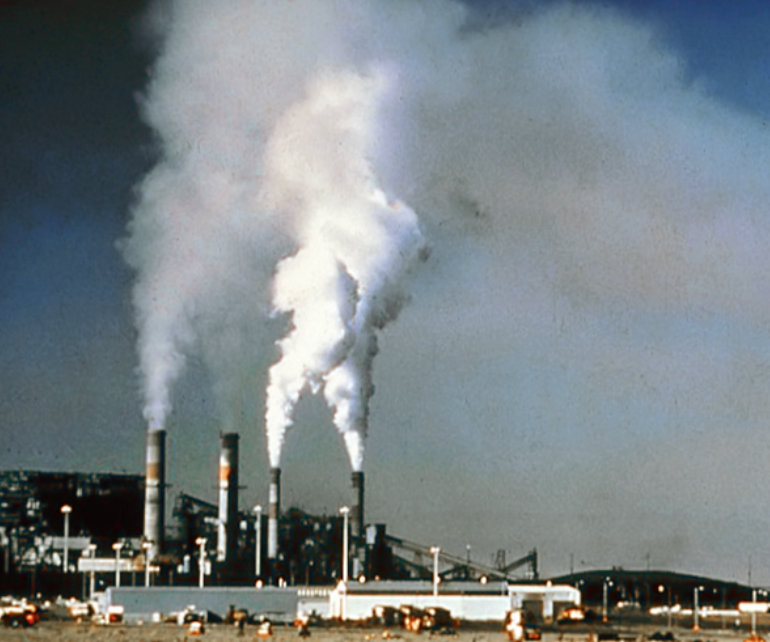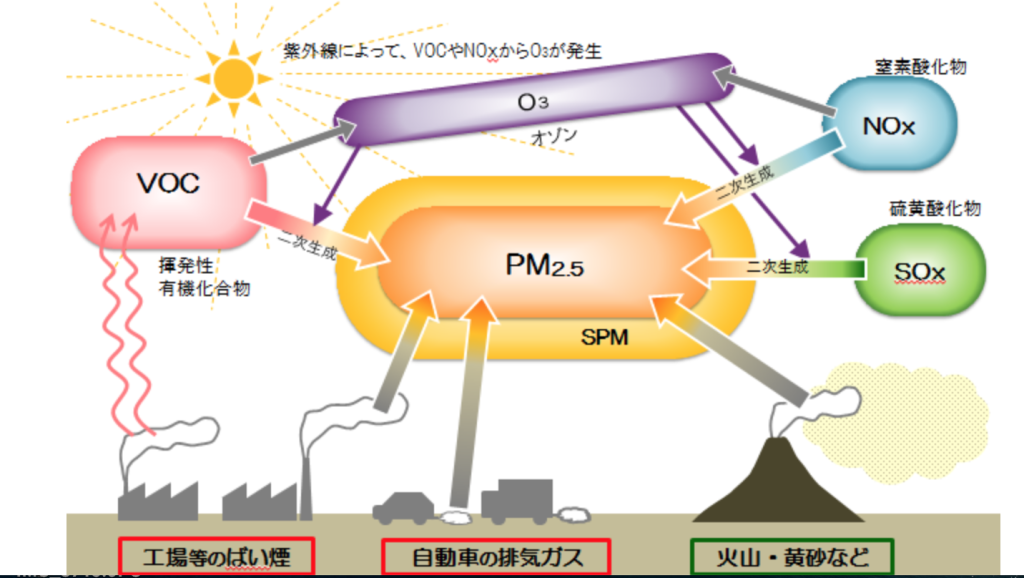
Is it better to live in clean air?
The answer to this question is obviously, yes. Fortunately, on Awaji Island the westward wind blows continuously from coast to coast, purifying the entire island, for an environment that is always healthy. However, have the benefits of clean air been scientifically proven? Recently, W. Hills et al. published a science paper examining the correlation between lung cancer and PM2.5 air-pollutants. Here, we briefly go over the results of the paper (Lung-adenocarcinoma promotion by air pollutants, W. Hill et al. Nature (2023) 616, p159-p167).

Fig. How PM2.5 pollutants are created? (HP: the Japanese Ministry of the Environment)

Fig. Intake of PM2.5 leads to inflammation of lung.
First of all, we need to understand what air-pollutants are. In the air, are many microscopic particles originally emitted from factories, cars, etc. There are also a multitude of microscopic crystals made of oxidized chemicals, like nitrogen oxide, which bind to air particles. In early spring, “yellow sand” consisting mainly of quartz, glass and clay is carried on the wind from mainland China to Japan, binding with various oxides in the air along the way. The small, airborne particulate matter measuring less than 2.5 micrometers are these days commonly known as PM 2.5. Intake of PM 2.5 is known to cause inflammation in our lungs. The branch of the United Nations concerned with health, the World Health Organization (WHO), has reported that the upper limit of air–pollutant intake, as set in their guidelines, is exceeded in more than 99 percent of living areas worldwide, meaning that about 7 million people inhale an unhealthy amount of air-pollutants, leading to 250,000 lung cancer deaths a year. Accordingly, the question has arisen of what exactly the relationship is between PM 2.5 and the onset of lung cancer.

Fig. PM 2.5 works as a promotor leading to carcinogenesis of the lung cells with a mutation of KRAS and/or EGFR gene.
W. Hills et al. studied this correlation of PM 2.5 and lung cancer in detail, following two independent lines of research; the first being epidemiological analysis, and the second being cellular analysis using lung cell lines in vitro. Based on their results, they concluded that PM 2.5 is causative of lung cancer as follows. In the first line of study, they analyzed the correlation between PM 2.5 concentrations and the onset of lung cancer in 32,957 lung cancer patients living in the UK, South Korea, Taiwan or Canada. These patients had been selected because they all carried oncogenic mutations in the oncogenic genes KRAS or EGFR. Mutations in these two genes have previously been reported to be found in most cases of lung cancer. The number of non-smoking patients in the UK, Taiwan and Korea was larger in areas with high concentrations of PM 2.5 than in areas with lower levels of PM 2.5. In these individuals, the oncogenic mutation in EGFR was more prevalent than KRAS mutations. In all areas, more oncogenic mutations were found in smoking patients than in non-smoking patients, independent of exposure to PM 2.5.
The second line of study examined the correlation of carcinogenic transformation of lung cells in vitro by PM 2.5 together with mutations in the EGFR gene. Two groups of cells were analyzed; one with a mutation in EGFR, and the other without a mutation. Adding PM 2.5 to the culture of lung cells with the mutation caused more frequent carcinogenesis than those without the mutation. Regarding carcinogenesis, PM 2.5 was thought to play a role in tumor promotion, similar to effects observed of an herbal extract, croton oil. When this oil is applied to our skin, it causes serious inflammation, possibly leading to carcinogenesis. This is known as tumor promotion and is not mutagenesis in an oncogenic gene. Such tumor promotion may be connected with “interleukin beta,” a factor known to be closely associated with inflammation and cell growth in general, which increases in inflammatory circumstances such as under the effects of croton oil. A similar increase of this factor was observed in the lungs of mice after intake of PM 2.5. Based on these observations and previous knowledge, the authors concluded that PM 2.5 works as a tumor promotor for the lung cells with an oncogenic mutation in EGRF gene. As expected, PM 2.5 caused less carcinogenesis for the lung cells without EGFR mutation in vitro. W. Hills et al. surveyed oncogenic mutations in KRAS and EGFR of people with no lung cancer symptoms. They found that 18 and 57 percent of the people carried spontaneous oncogenic mutations in EGFR and KRAS, respectively. Taking the first and second line of research data together, W. Hills et al. concluded that PM 2.5 promotes lung cancer mainly in lung cells with pre-existing mutations in the EGFR gene.
As described by W. Hills et al., the air pollutant PM 2.5 increases the likelihood of lung cancer. This scientific finding suggests that an environment of clean air is important for a healthy life. In Japan anti-air pollution law requires the establishment of observatories to measure PM 2.5 concentration in every prefecture, with about 700 stations nationwide. Each hour the current PM 2.5 concentrations hour by hour is reported. Such reports of PM 2.5 concentrations can help people judge the suitability of certain living environments. In the paper by W. Hills et al. the importance of developing medicine and foods to mitigate the effects of air pollutants like PM 2.5 is emphasized.
